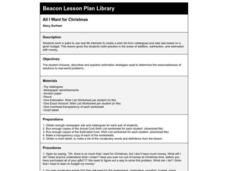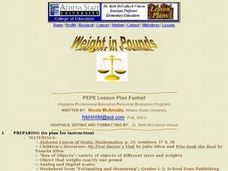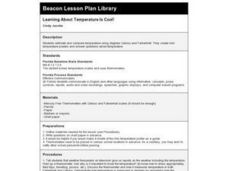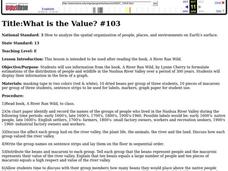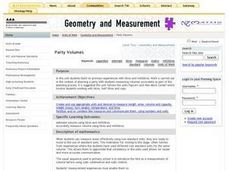Curated OER
FOOTSTEPS IN TIME
Students measure and correlate their foot lengths and body heights, then use this data to estimate height of Laetoli hominids. They use metric measurement and graphing to determine these heights.
Curated OER
Go Fish!
Eighth graders use goldfish crackers to simulate a capture-recapture method of data collection. They fill in a chart and determine the averages. They find the estimated population of fish and the actual population of fish based on the...
Curated OER
All I Want For Christmas
Fourth graders create wish lists from catalogues and sales ads based on a given budget. They add, subtract, estimate, and budget their given amount of money so they don't go over budget.
Curated OER
Peer Pressure
Sixth graders estimate, calculate and collaborate with students. They practice refusal skills.
Curated OER
Radiation: To Worry or Not to Worry
Students distinguish safe forms of radiation from those that are dangerous. Students watch a video about sources of radiation encountered every day. Students estimate their own annual radiation exposure.
Curated OER
Radiation: To Worry or Not to Worry
Learners distinguish safe forms of radiation from those that are dangerous. Students watch a video about sources of radiation encountered every day. Learners estimate their own annual radiation exposure.
Curated OER
Weight
Third graders select appropriate units for measuring and solving problems in customary systems, identify equivalent measures within measurement system, and estimate, determine, record, and discuss weight using appropriate customary...
Curated OER
Weights in Pounds
Second graders define "pound," estimate and compare weights, and classify objects as weighing more or less than a pound.
Curated OER
Learning About Temperature Is Cool!
Young scholars estimate and compare temperature using degrees Celsius and Fahrenheit, and create mini temperature posters and answer questions about temperature.
Curated OER
Lesson 5-Elaborate/Evaluate Too Loud, Too Close, Too Long
Students begin with an analysis of loudness. They estimate the loudness of common environmental sounds, and then use their knowledge of hearing and loudness to evaluate the risk of noise-induced hearing loss for fictitious individuals....
Curated OER
Introductory Microbiology
Young scholars view a Reading Rainbow video on germs and discuss microbial diseases. They grow cultures of Staphylococcus aureus and then estimate and graph the count for their own bodies and those of the class.
Curated OER
Butterflies in the Garden
Students estimate the population of a butterfly ecosystem and create a chart and graph based on information they find.
Curated OER
Speed Trap
Young scholars explore the usefulness of algebraic skill development as they make decisions based on their ability to accurately estimate the speed of moving vehicles. The life and death possibilities place an interesting"spin" on this...
Curated OER
Speed of Sound
Learners examine the phenomenon of sounds traveling slower than light. They discover why they see things before they hear them and how to estimate the speed of sound as homework.
Curated OER
Health Styles
Pupils define and compare health terms. They estimate a person's health status on each dimension of health. They describe the major determinants of health.
Curated OER
Least Squares Fit Line
Students estimate the least squares fit line for a set of data. They understand error involved in least square fit lines. They solve application problems using least square fit lines.
Curated OER
Prey or Pray? Could YOU Escape a Cheetah?
Tenth graders estimate the size of an adult cheetah by research and measurement of a picture. They determine the approximate distance and speed of the cheetah from a filmed chase and compare that to their own running speed.
Curated OER
Hemingway Hangouts
Students use printed maps and websites to estimate driving distances and plan routes to Hemingway's home. They visit several locations online and record facts about each location.They calculate, distances, driving time, and other factors.
Curated OER
Infinite Secrets
Students duplicate the method that Archimedes used to estimate the value of pi. They complete a data table and find the approximate values of pi for three sets of polygons.
Curated OER
What is the Value?
Students formulate estimations of the distribution of people and wildlife in the Nashua River Valley over a period of 300 years. They listen to the book, "A River Ran Wild," identify and record the names of the groups of people who...
Curated OER
Let's Measure
Students discuss comparing the size of two different sets of blocks. They estimate the length of the long blocks by answering the following questions: How can you use the small blocks to find out?, and How many small blocks does it...
Curated OER
Party Volumes: Measurement
Second graders explore liters and milliliters. They estimate volume and accurately measure the volume. Students plan a party and measure volume using liters and milliliters as part of the planning process.
Curated OER
Slosh, Dribble, and Plop
Students recognize the need for a standard unit of volume. They estimate and measure to the nearest liter. Also they relate the liter to the familiar everyday containers.
Curated OER
Clay Hill Animal Sampling
Students create animal print casts from molds in the classroom. They use the cast patterns to identify animal prints on a field trip in which they locate animal tracks, identify the location with GPS and create field casts of the...
Other popular searches
- Estimate Fractions
- Compatible Numbers to Estimate
- Estimate Angle Measurement
- Estimate and Measure Length
- Estimate Quotient
- Estimate the Sum
- Estimate Percent
- Estimate Measure Weight
- Estimate by Rounding
- Magnitude Estimates
- Estimate Numbers
- Estimate Fractions For




